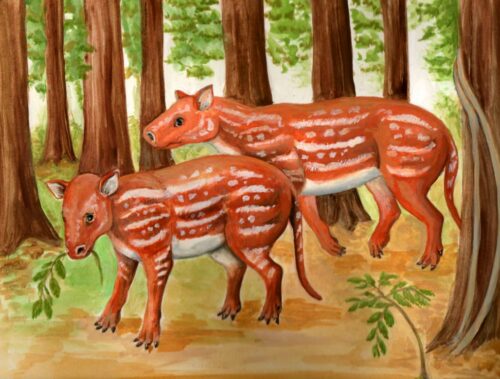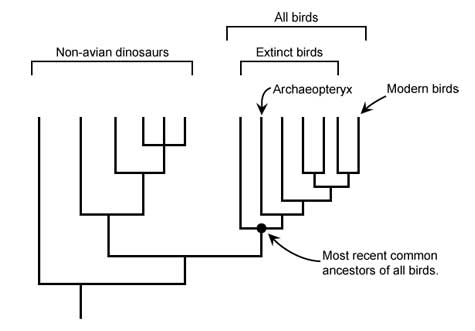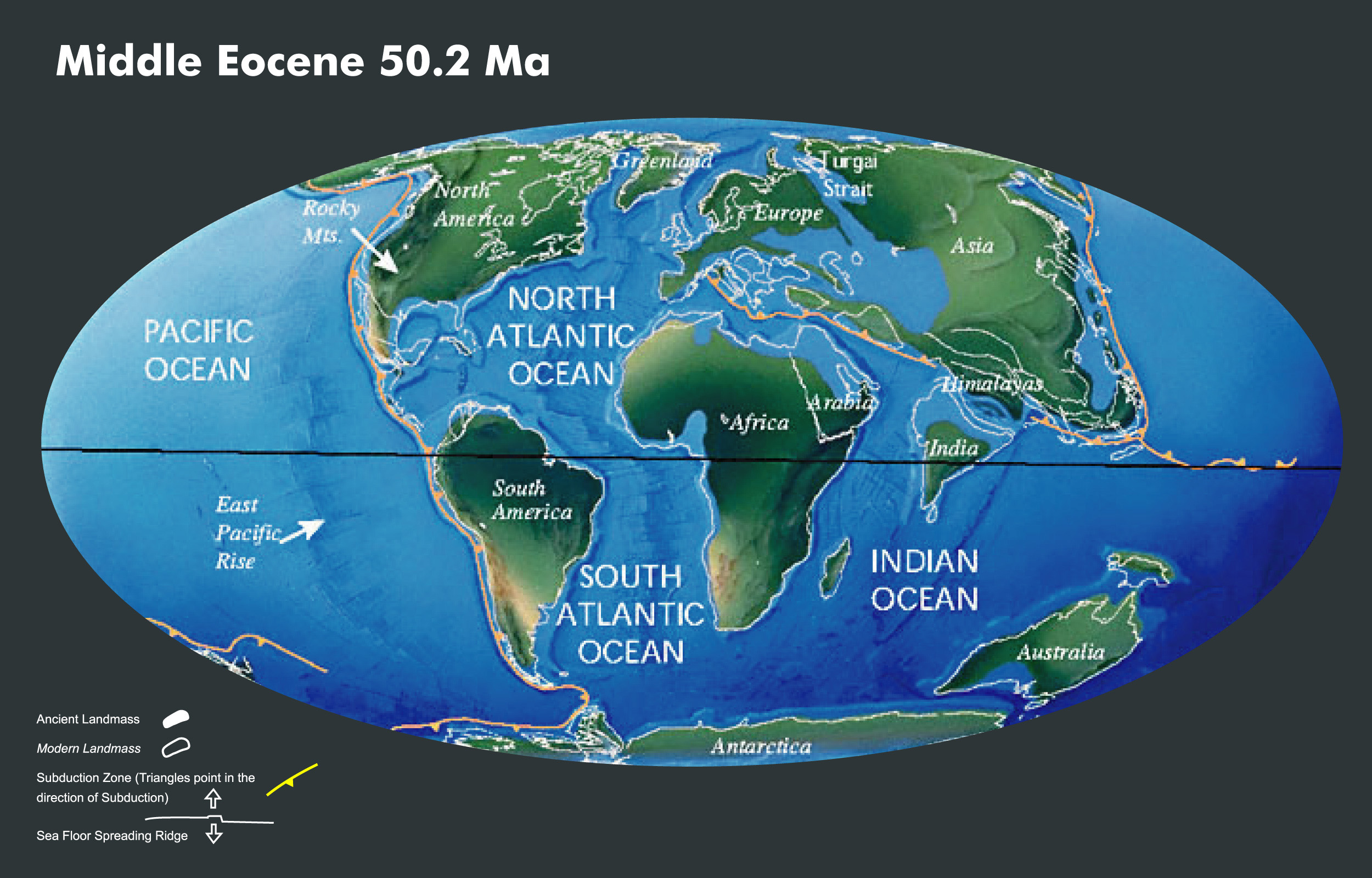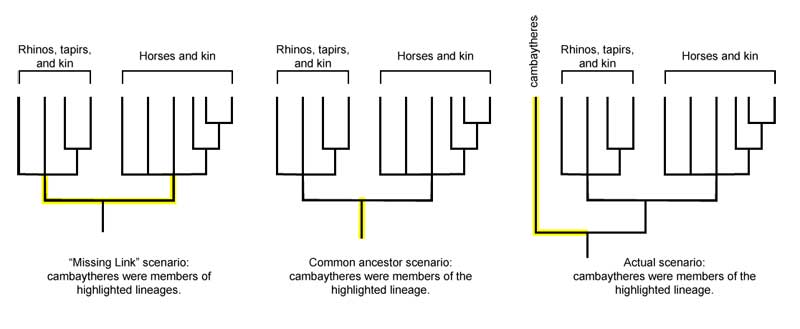
Last month, scientists announced the discovery of 55-million-year-old fossils that belonged to a mammal from ancient India, Cambaytherium thewissi. The hoofed animal may not have been particularly distinctive looking — it would have weighed between 45 and 75 pounds, resembling a cross between a wild boar and a tapir — but it does occupy a distinctive place on the Tree of Life. Some news outlets immediately began heralding the discovery as a “missing evolutionary link” between horses and rhinos, or their common ancestor. As it turns out, neither is true…
Where's the evolution?
Nine years ago when cambaythere fossils were first found, paleontologists weren’t sure what they were. Biologists argued over whether they were even-toed ungulates (i.e., artiodactyls, a clade that includes pigs, camels, cows, and whales), odd-toed ungulates (i.e., perissodactyls, a clade that includes horses, rhinos, and tapirs), or afrotheres (a clade that includes elephants, sea cows, and aardvarks). The new cambaythere fossils discovered in an Indian coal mine now make the answer clear. A careful study of their anatomy and a reconstruction of their evolutionary tree revealed them to be close cousins of early perissodactyls.
So, why then, if cambaytheres are so closely related to rhinos and horses, can’t we call them a “missing link?” Because of their position on the Tree of Life. As shown below, if cambaytheres were a “missing link,” it would imply that they are part of the ancestral lineage of either horses or rhinos and “link” these two animals to one another. Neither are cambaytheres the common ancestor of horses and rhinos. In fact, cambaytheres are not part of the ancestral lineage of rhinos or horses at all; they are simply close relatives of those ancestors.
Paleontologists know that these “linking” lineages and ancestral lineages existed, but they don’t necessarily expect to find these organisms in the fossil record. That’s because the fossil record preserves only a miniscule proportion of the species that were alive at any given time period and because only a tiny proportion of fossils are exposed for us to discover. One study estimated that less than 2% of marine species preserved as fossils have been described! Furthermore, the direct ancestors of modern species (e.g., of horses and/or rhinos) would have been vastly outnumbered by related lineages that are not direct ancestors (e.g., cambaytheres). Hence, it’s just much more likely for a scientist to discover a fossil organism that is a relative of an ancestor than the organism that is that ancestor. It’s a bit like choosing a birth certificate at random from those in the files of the town where your family has lived for generations. The odds that you just happen to pick a direct ancestor of your own (e.g., mom, dad, grandma, etc.) is slim, but the chance that you pick second a cousin, grand-aunt, or other relative who is not a direct ancestor of yours is much higher — because there are just a lot more of them.
Extinct species that are closely related to the direct ancestors of modern species are often called transitional forms because they help us understand how an evolutionary transition — such as the origin of the Perissodactyla — occurred. Transitional forms don’t have the exact features that the ancestral lineage had, but they often have much in common with them. In addition, the more branches of a group’s phylogenetic tree that we can discover and learn about, the more accurately we can deduce what traits the ancestral lineage had.
 In the vast majority of cases, the fossil “ancestors” or “missing links” reported by the media are, according the scientists behind the research, actually not ancestors at all; they are close relatives of those ancestors. For example, Archaeopteryx has often been described as the ancestral bird or the “missing link” between dinosaurs and birds, but it is actually just a lineage of birds that branched off soon after the bird clade originated, as shown at right. Archaeopteryx is important because it helped show how modern birds could have evolved from non-avian dinosaurs, but it is not a missing link or an ancestor of modern birds. One case in which scientists may actually mean to present a fossil organism as a direct ancestor of modern species is in human evolution. For example, it may be that Homo erectus and Homo habilis are actually direct ancestors of modern humans. Such hypotheses are often hotly contested, but because human relatives lived recently and are fairly well-represented in the fossil record, discovering the direct ancestor of a modern species is a much more likely scenario in our own group.
In the vast majority of cases, the fossil “ancestors” or “missing links” reported by the media are, according the scientists behind the research, actually not ancestors at all; they are close relatives of those ancestors. For example, Archaeopteryx has often been described as the ancestral bird or the “missing link” between dinosaurs and birds, but it is actually just a lineage of birds that branched off soon after the bird clade originated, as shown at right. Archaeopteryx is important because it helped show how modern birds could have evolved from non-avian dinosaurs, but it is not a missing link or an ancestor of modern birds. One case in which scientists may actually mean to present a fossil organism as a direct ancestor of modern species is in human evolution. For example, it may be that Homo erectus and Homo habilis are actually direct ancestors of modern humans. Such hypotheses are often hotly contested, but because human relatives lived recently and are fairly well-represented in the fossil record, discovering the direct ancestor of a modern species is a much more likely scenario in our own group.
Understanding that most fossil discoveries represent extinct relatives and not the ancestors of modern forms is important because it gives us a more accurate picture of evolution overall — as a vastly pruned bush with just a few surviving lineages, rather than as a march of progress, with ancient species transforming inevitably into modern organisms. In this case, we can see that, though there are only a few species of horses, tapirs, and rhinos alive today, their history is rich and diverse. Species like C. thewissi, which branched off just before the Perissodactyla originated, along with other fossil forms, give us a more complete understanding of that history. One of the most interesting aspects of the C. thewissi discovery is the fact that these 55-million-year-old fossils were discovered in India. At that time, India was an island on a collision course for Asia, after having broken off of Antarctica and Madagascar as it moved through Earth’s ancient Tethys Ocean. Finding cambaytheres of this age in India suggests an itinerant history for the Perissodactyla. The ancestors of both Cambaytherium and Perissodactyla probably lived on the land mass that is today Africa and the Arabian Peninsula. As India glided by, en route to Asia, a land bridge may have allowed these organisms to migrate onto the island. There, true perissodactyls evolved. When India crashed into Asia, pushing up the Himalayas, it also brought perissodactyls to the larger land mass. Once there, perissodactyls diversified and spread throughout the world, forming a bushy family tree, of which only a few have survived until today.

Primary literature:
- Rose, K. D., Holbrook, L. T., Rana, R. S., Kumar, K., Jones, K. E., Ahrens, H. E.,... Smith, T. (2014). Early Eocene fossils suggest that the mammalian order Perissodactyla originated in India. Nature Communications. doi:10.1038/ncomms6570. Read it »
News articles:
- A quick summary of the discovery from NBC News
- A blog post on the research from National Geographic
- A blog post addressing misconceptions surrounding the idea of "missing links" from NCSE
Understanding Evolution resources:
-
- In your own words, describe the difference between a transitional form and a “missing link.”
- The Los Angeles Times story about this research was titled “Rhino horse, a ‘missing link,’could solve 55-million-year-old mystery”. Explain what aspects of this title could be misleading and why. Suggest a more accurate title for the story.
- List three reasons that finding the direct ancestors of modern species in the fossil record is unlikely.
- Advanced: Read our research profile on Leslea Hlusko. How does the scientific controversy over the relationship between Australopithecus anamensis and Ardipithicus ramidus described in that profile relate to the research described here?
- Advanced: Find another example of a fossil discovery that media outlets have described as a “missing link” online. Do some additional research on this organism and explain scientists’ hypothesis regarding the fossil form’s relationship to modern species. Include a drawing of a phylogenetic tree in your explanation if it helps.
- Teach about how fossils are formed: In this interactive module for grades 6-8, students are introduced to fossils and the fossilization process by examining how fossils are formed and the factors that promote or prevent fossilization.
- Teach about how scientists learn about the past: This web-based module for grades 6-12 provides students with a basic understanding of how fossils can be used to interpret the past.
- Teach about transitional forms: This news brief for grades 9-16 describes the discovery of a new mammal species that highlights just how long mammals have been around and debunks the notion of a "missing link."
- Godefroit, P., Cau, A., Dong-Yu, H., Escuillié, F., Wenhao, W., and Dyke, G. (2013). A Jurassic avialan dinosaur from China resolves the early phylogenetic history of birds. Nature 498: 359-362.
- Kidwell, S., and Sepkoski, J. J. (1999). The nature of the fossil record. In: J. Scotchmoor and D. A. Springer (eds.), Evolution, Investigating the Evidence. Paleontological Society, Special Publication, Volume 9.
- Rose, K. D., Holbrook, L. T., Rana, R. S., Kumar, K., Jones, K. E., Ahrens, H. E.,... Smith, T. (2014). Early Eocene fossils suggest that the mammalian order Perissodactyla originated in India. Nature Communications. doi:10.1038/ncomms6570. http://pages.geo.wvu.edu/~kammer/g231/readings/kidwell_sepkoski.pdf

